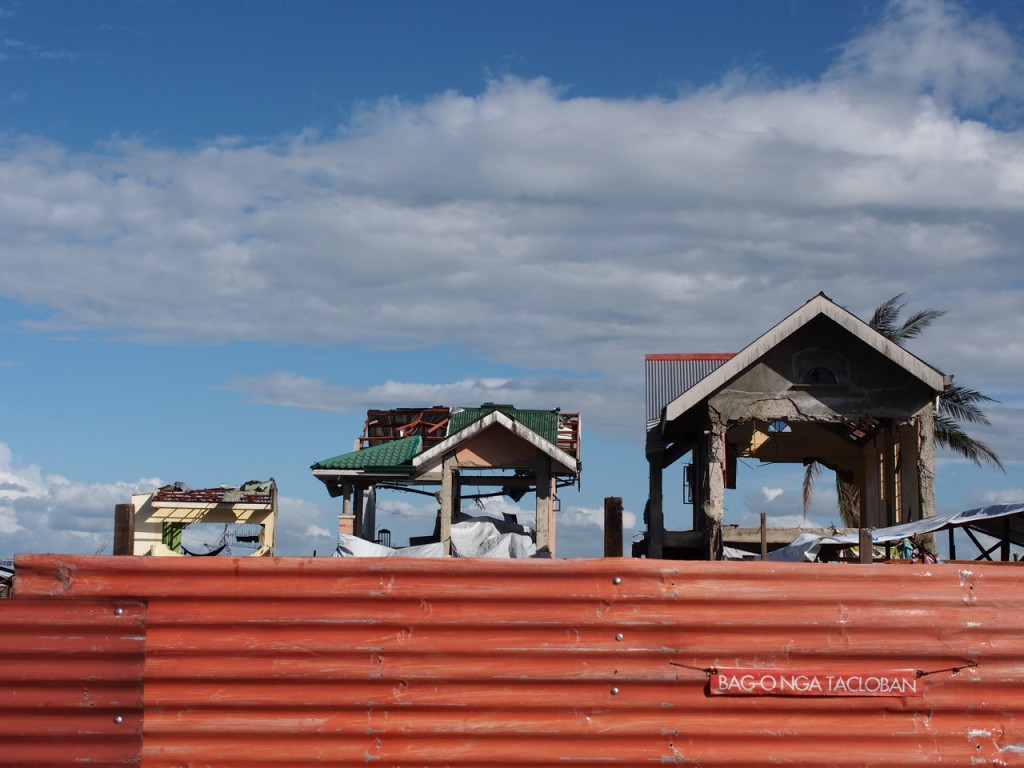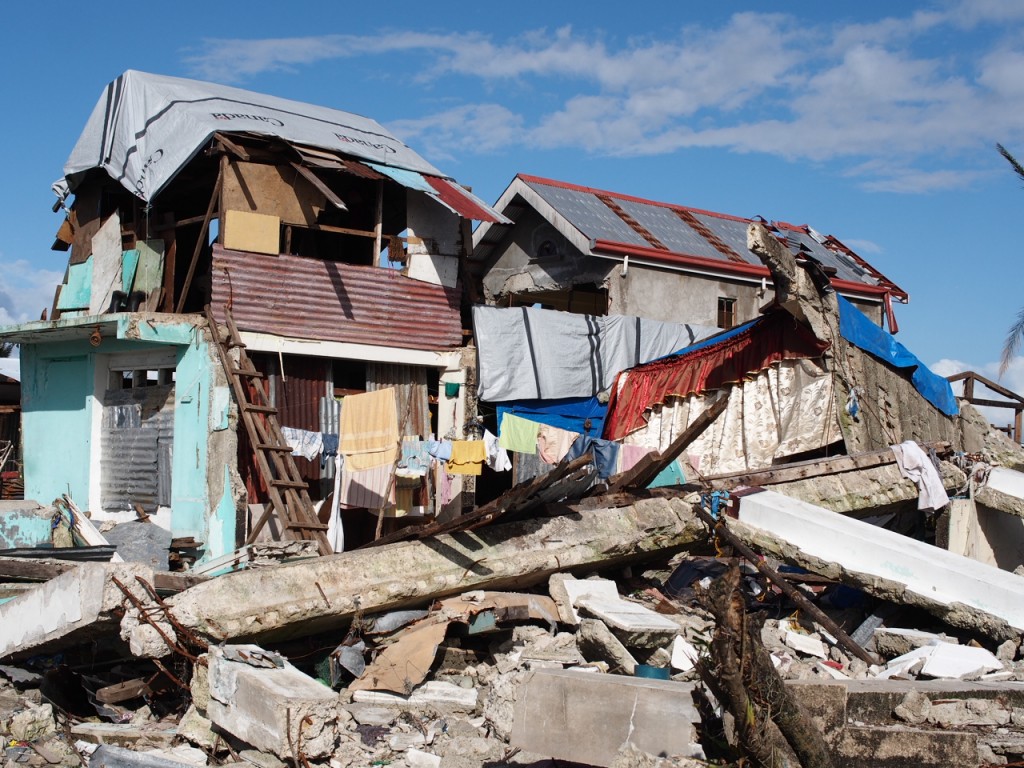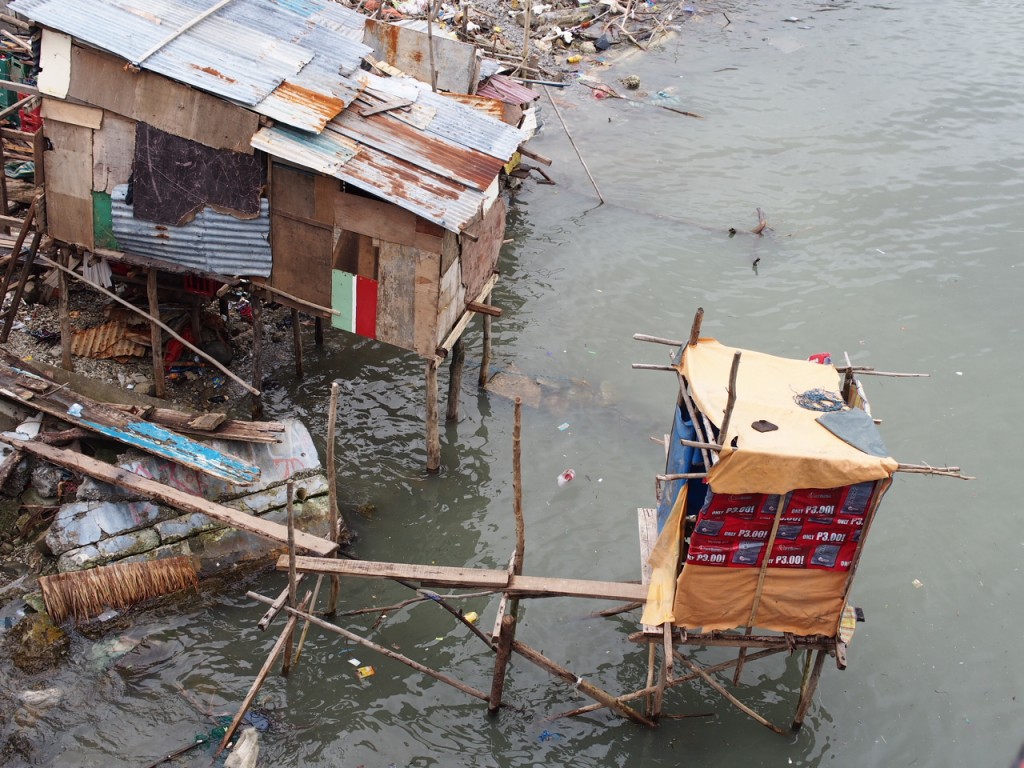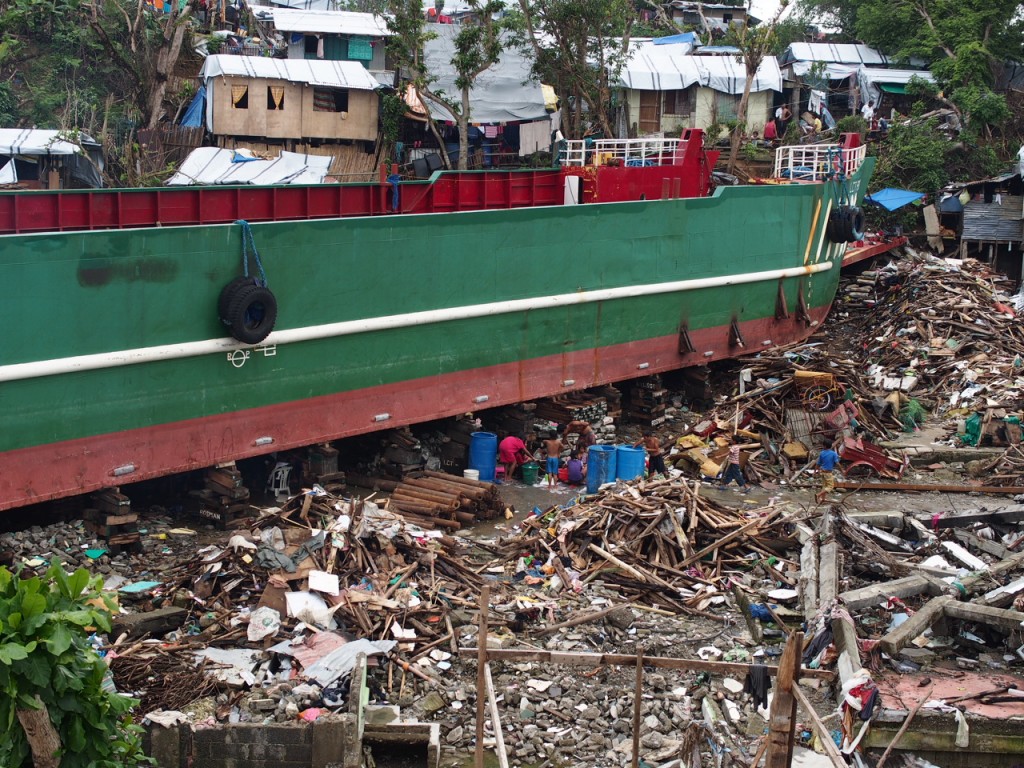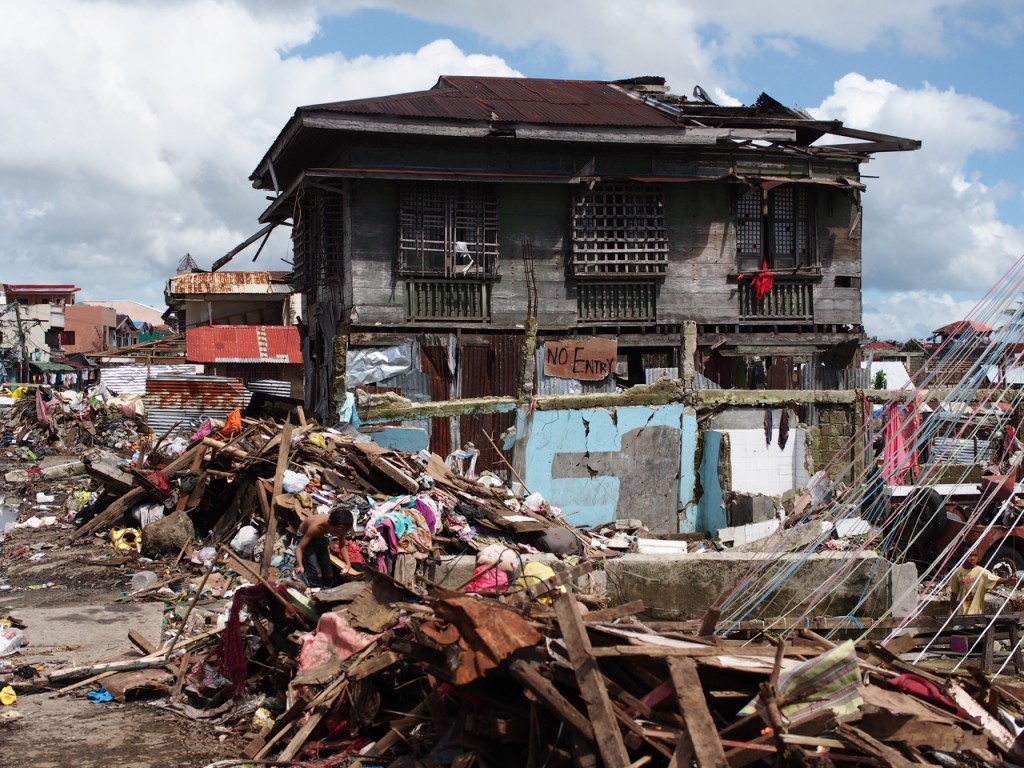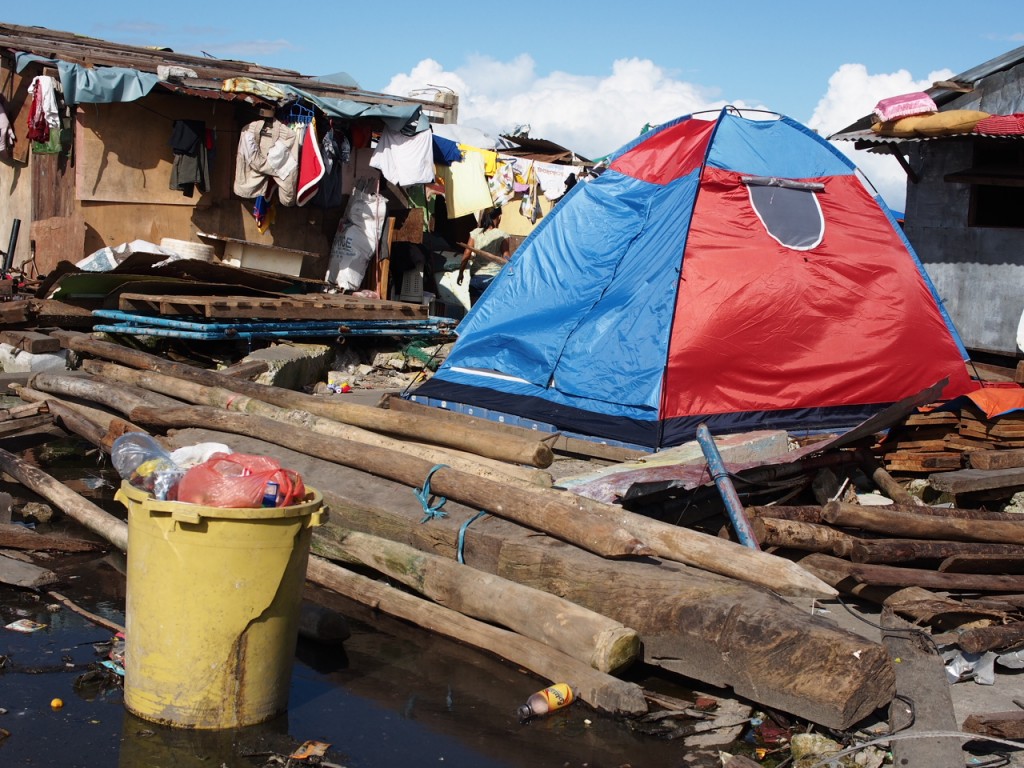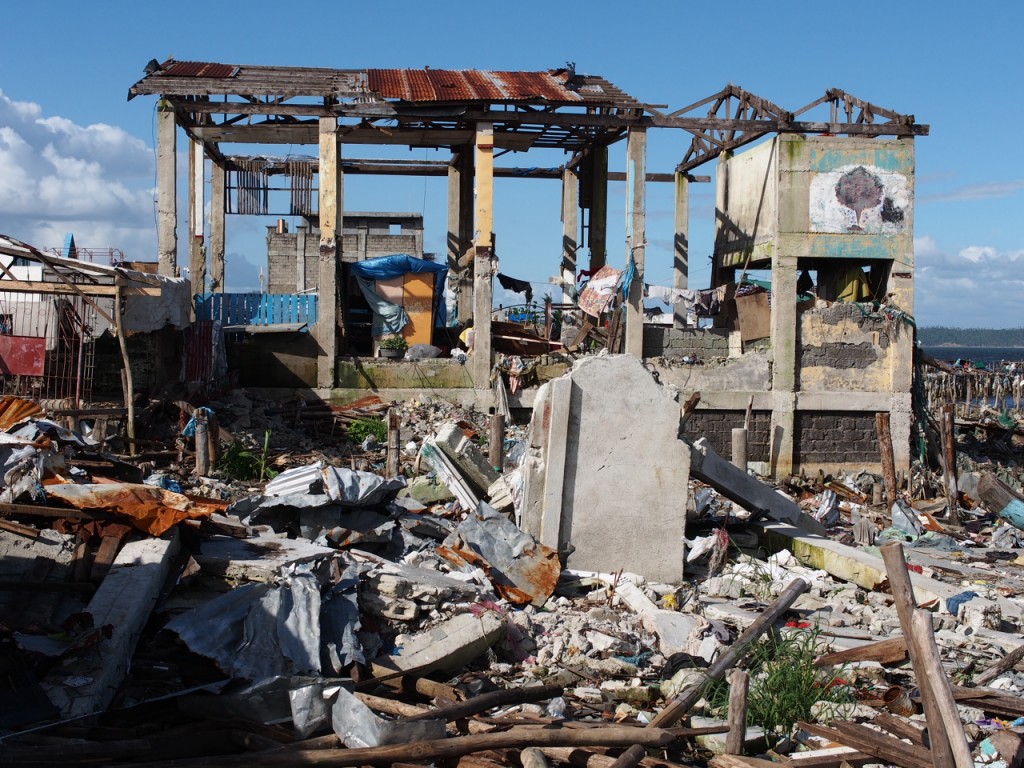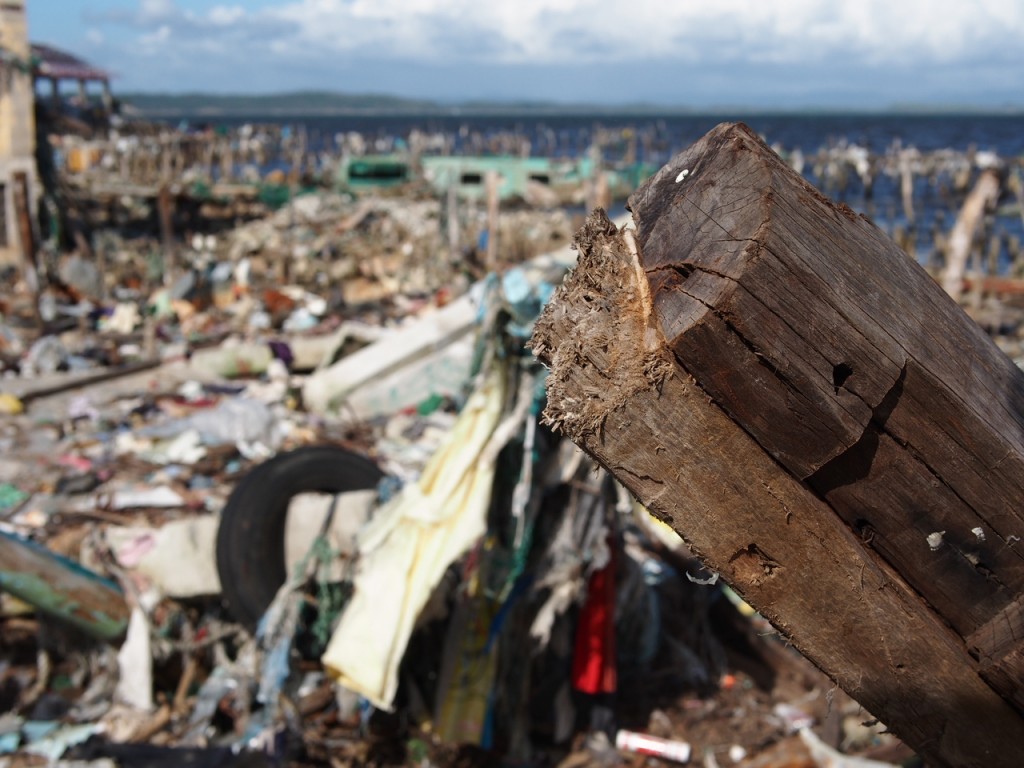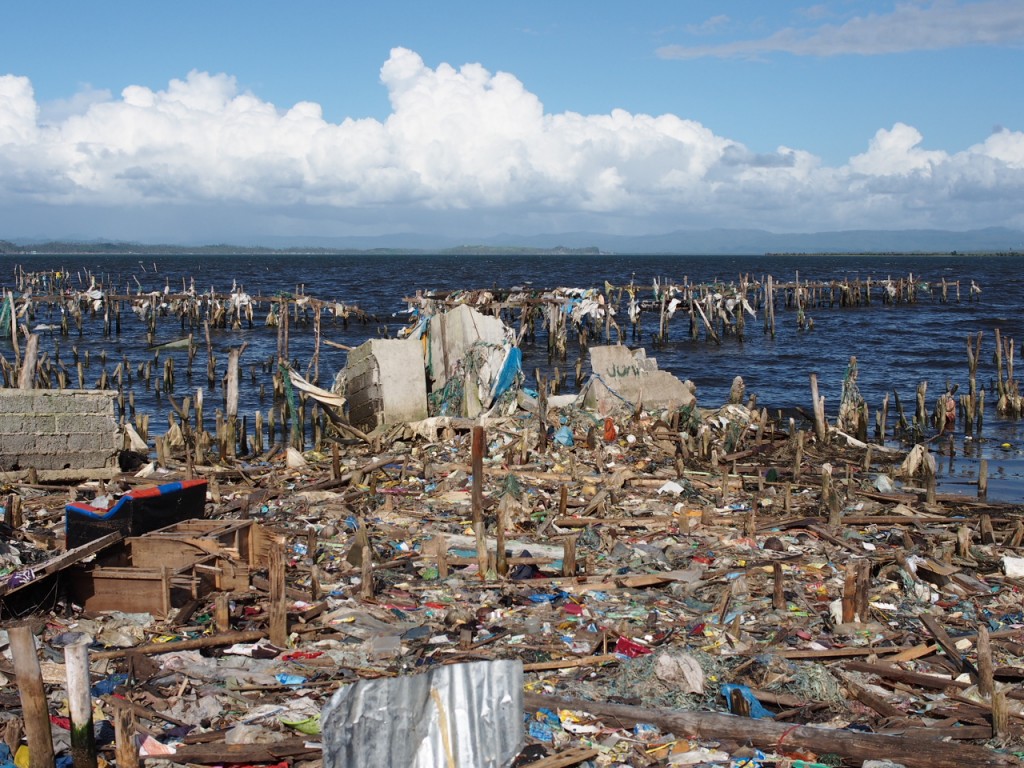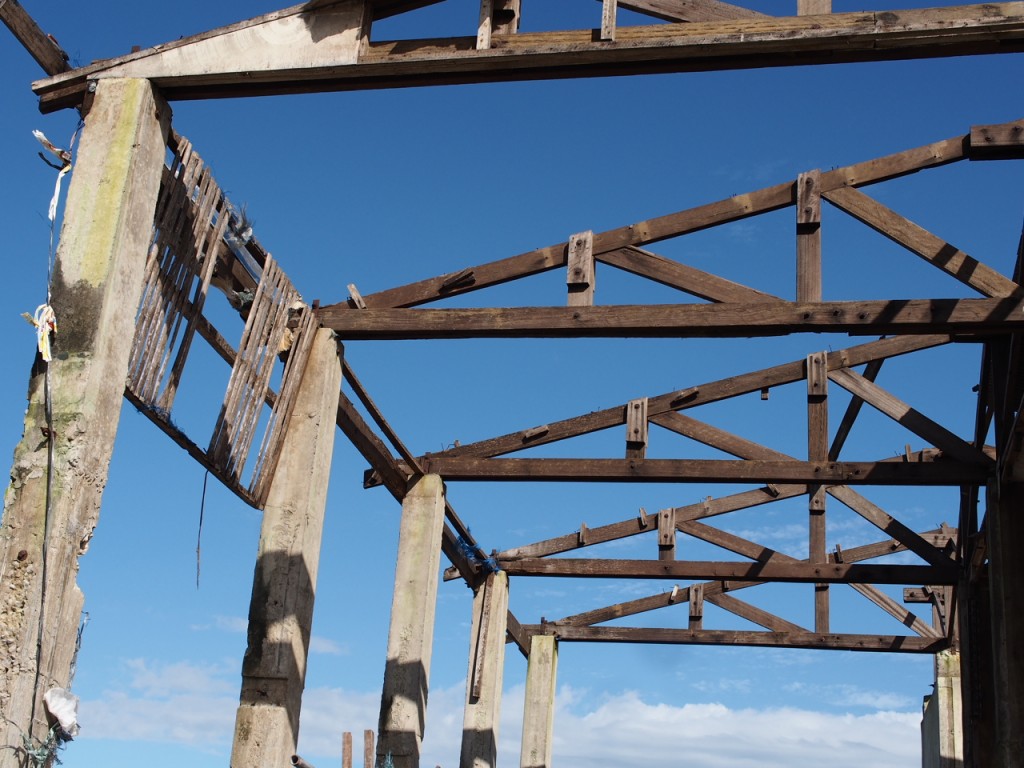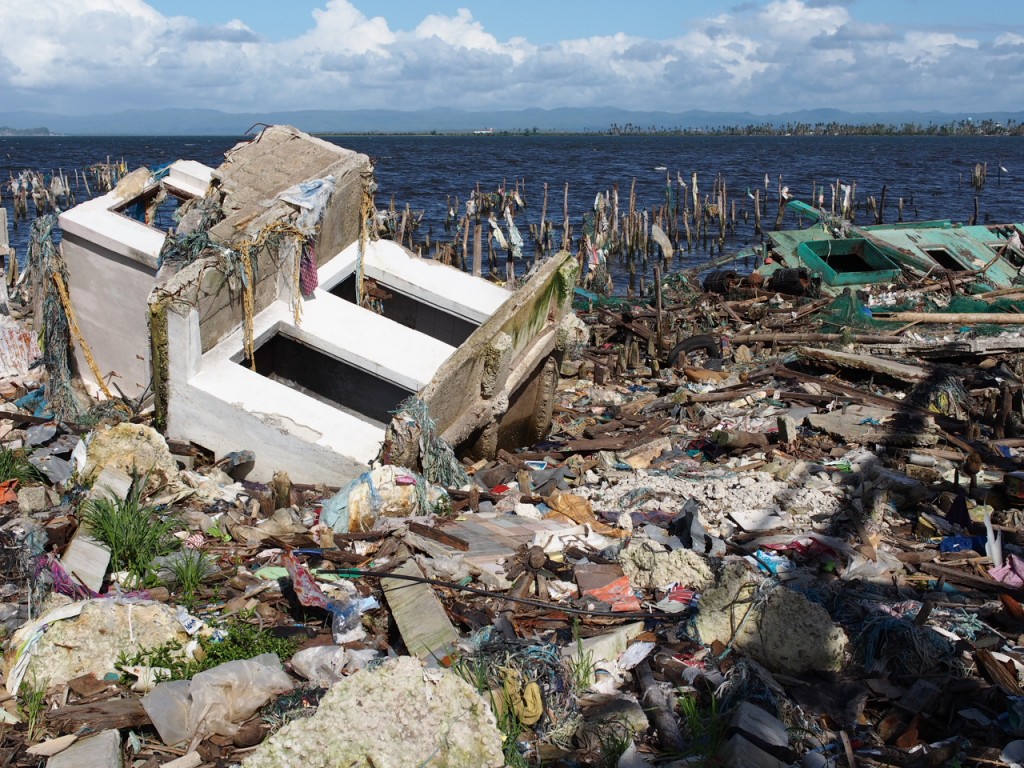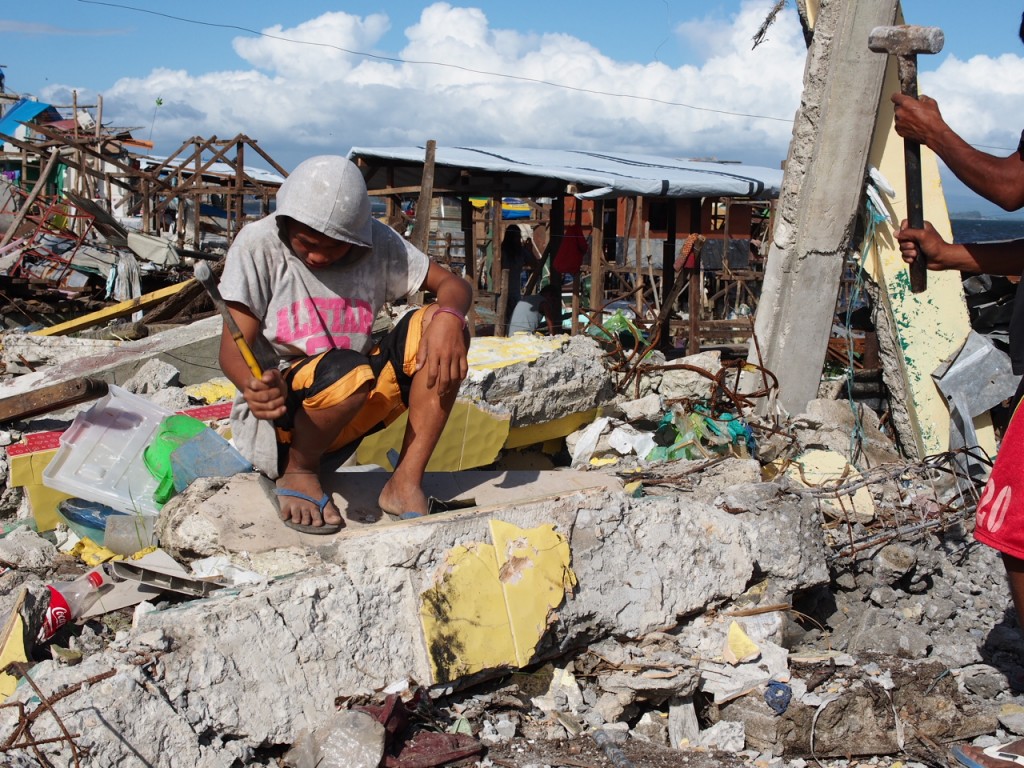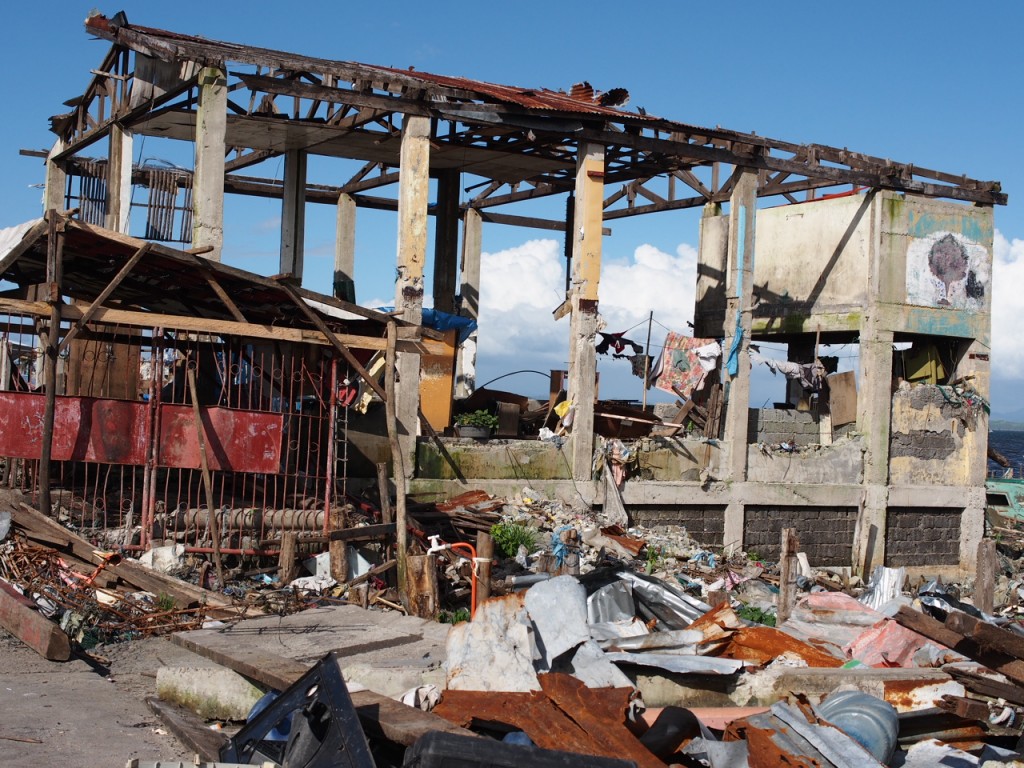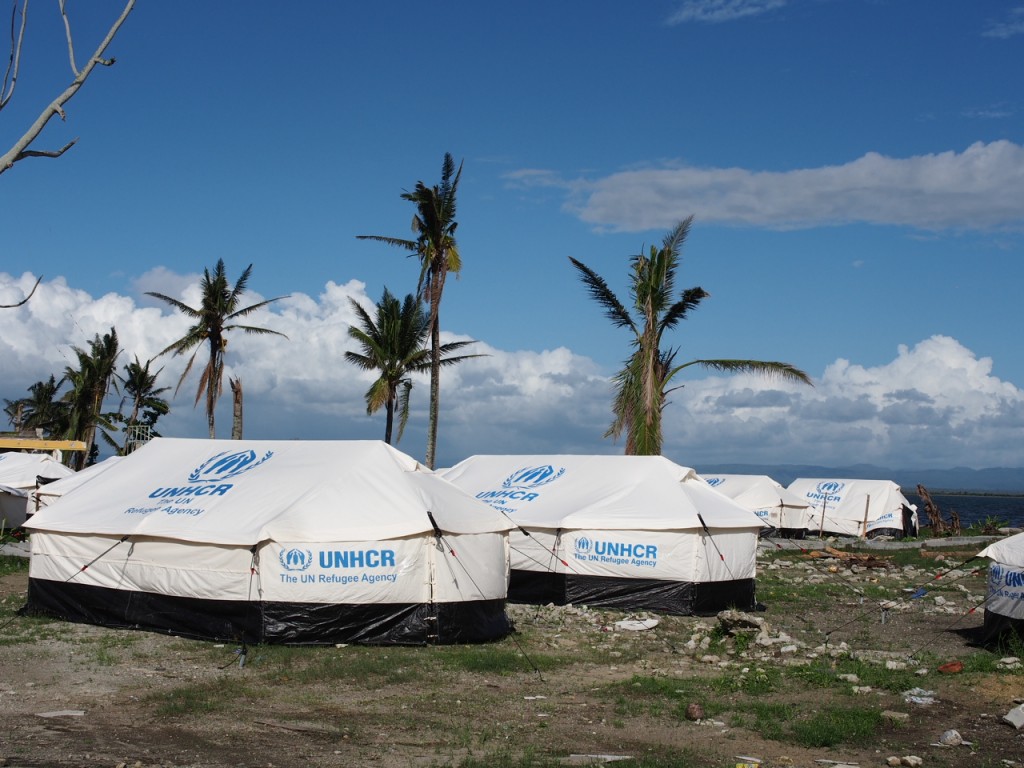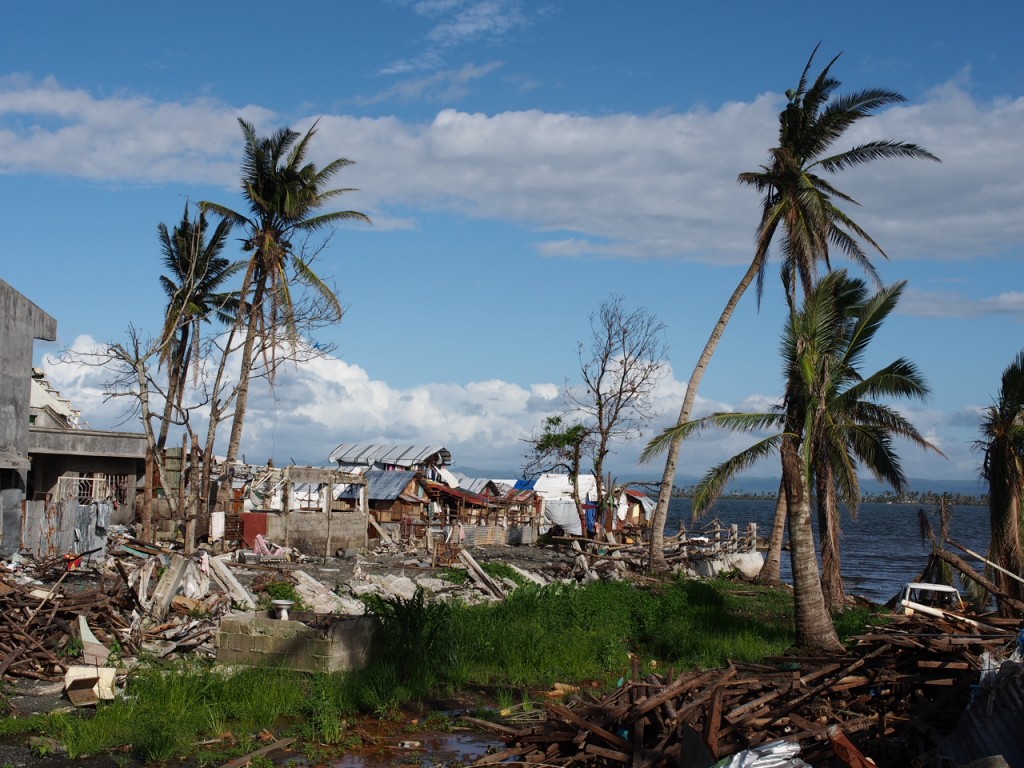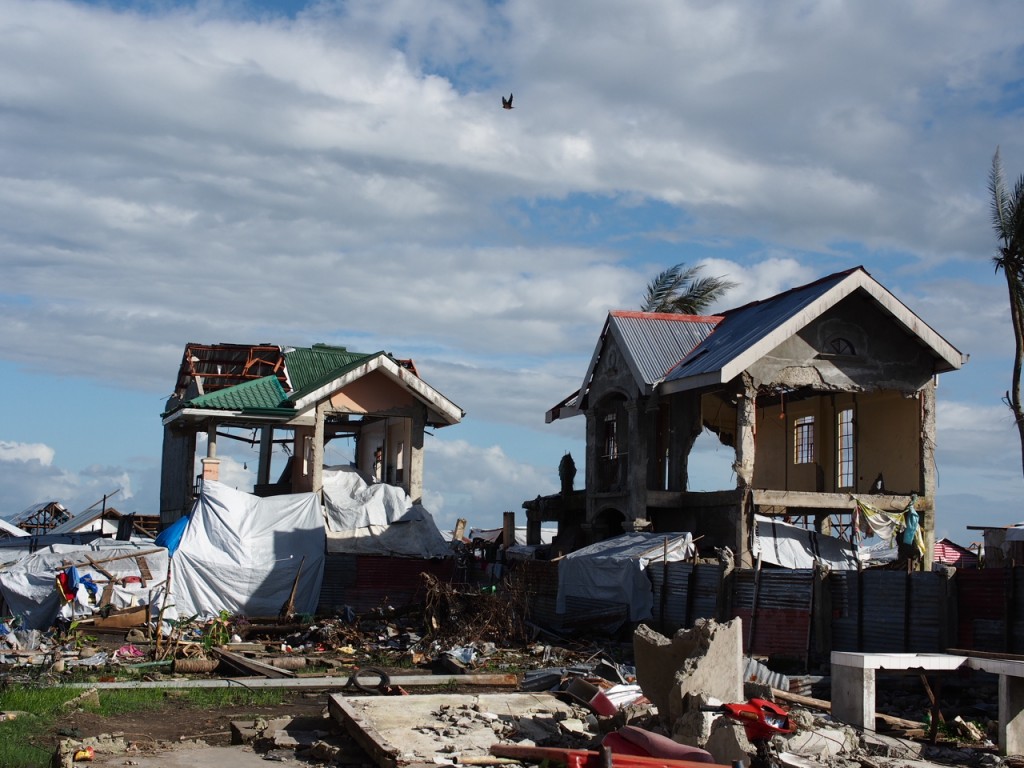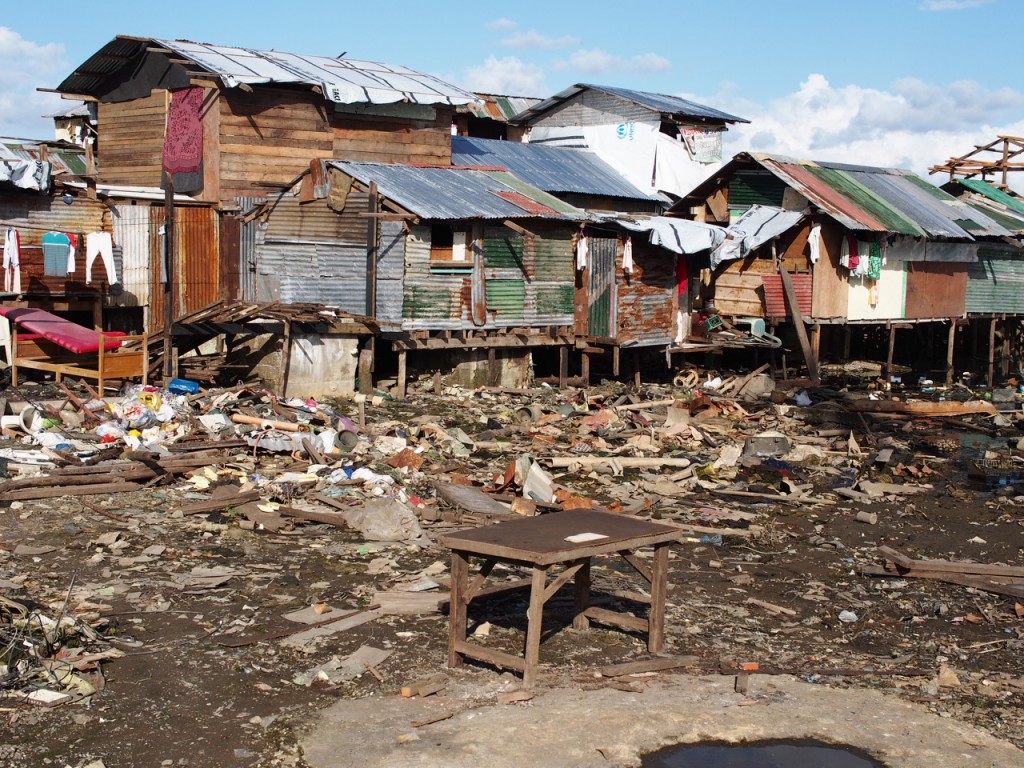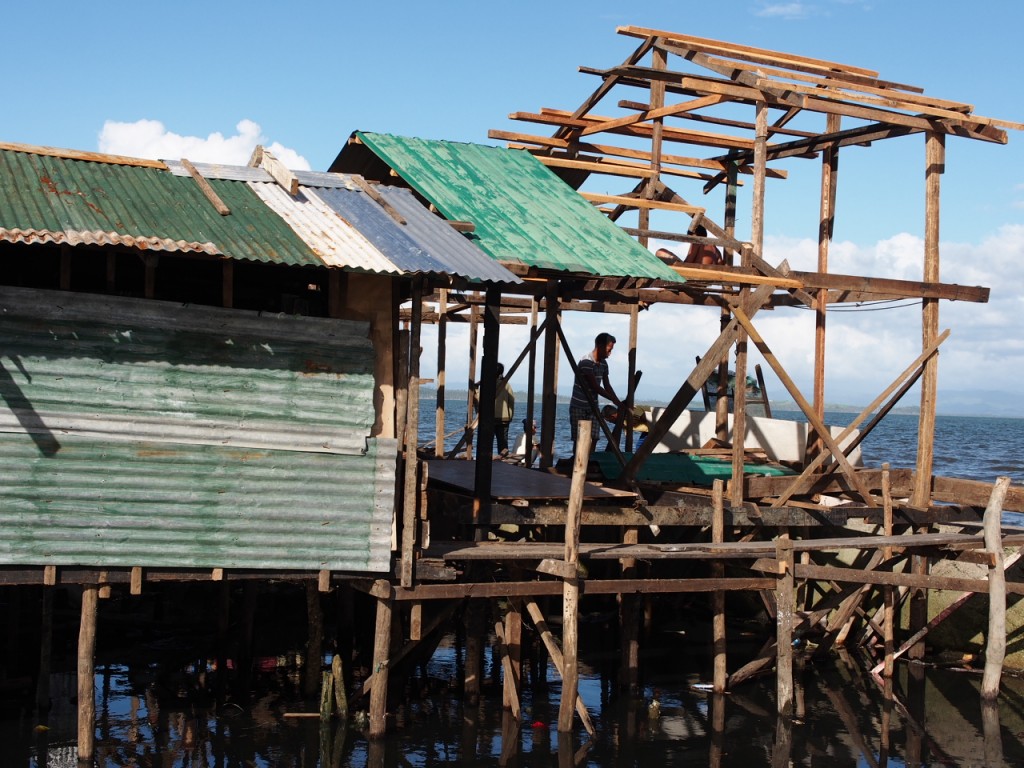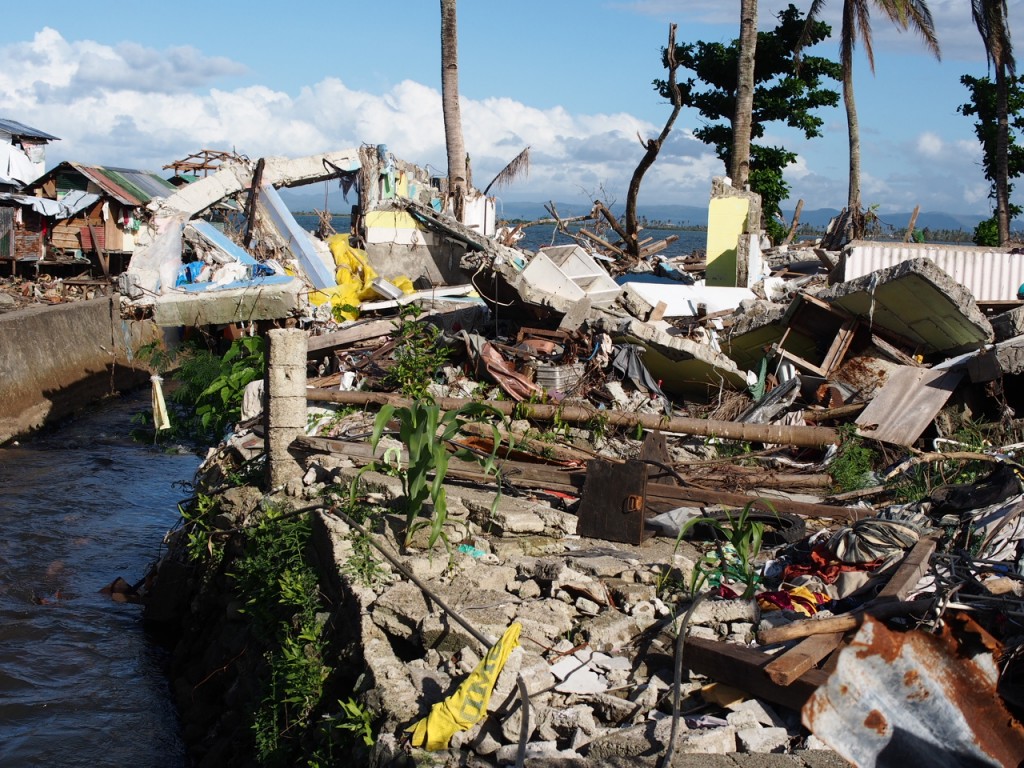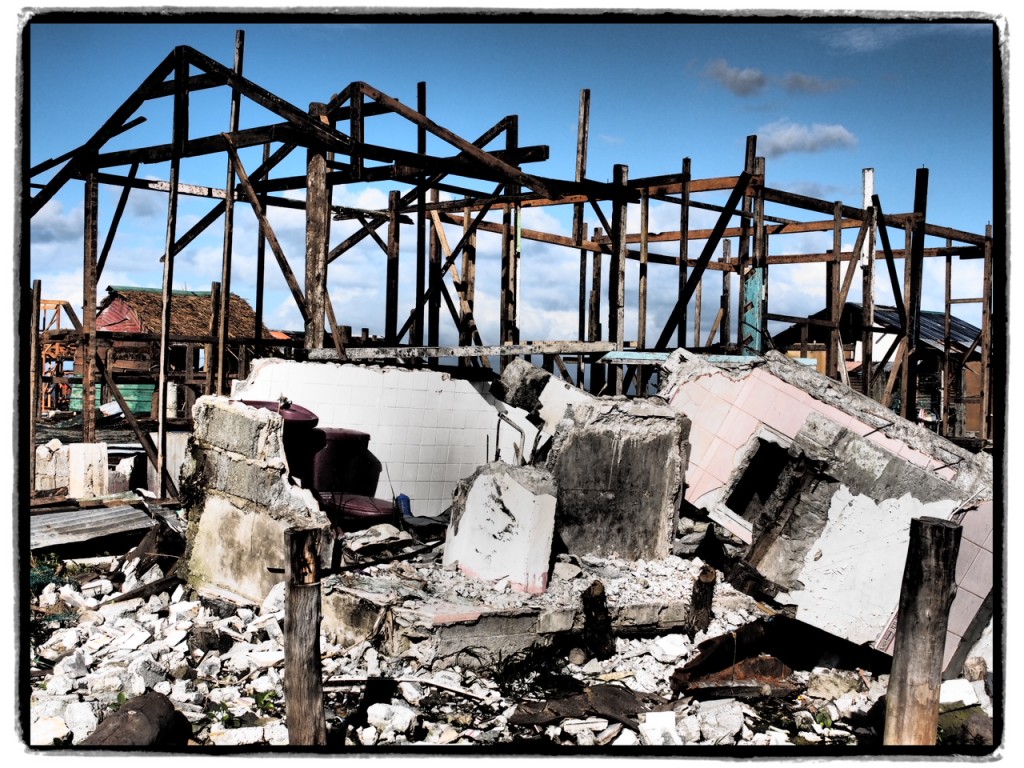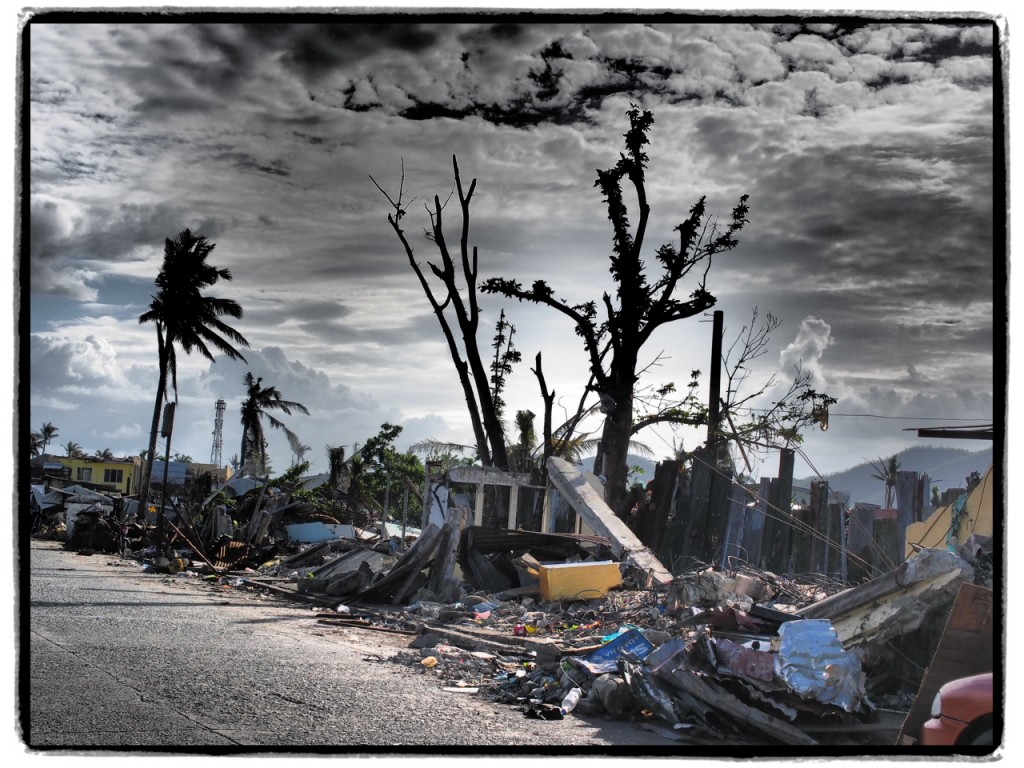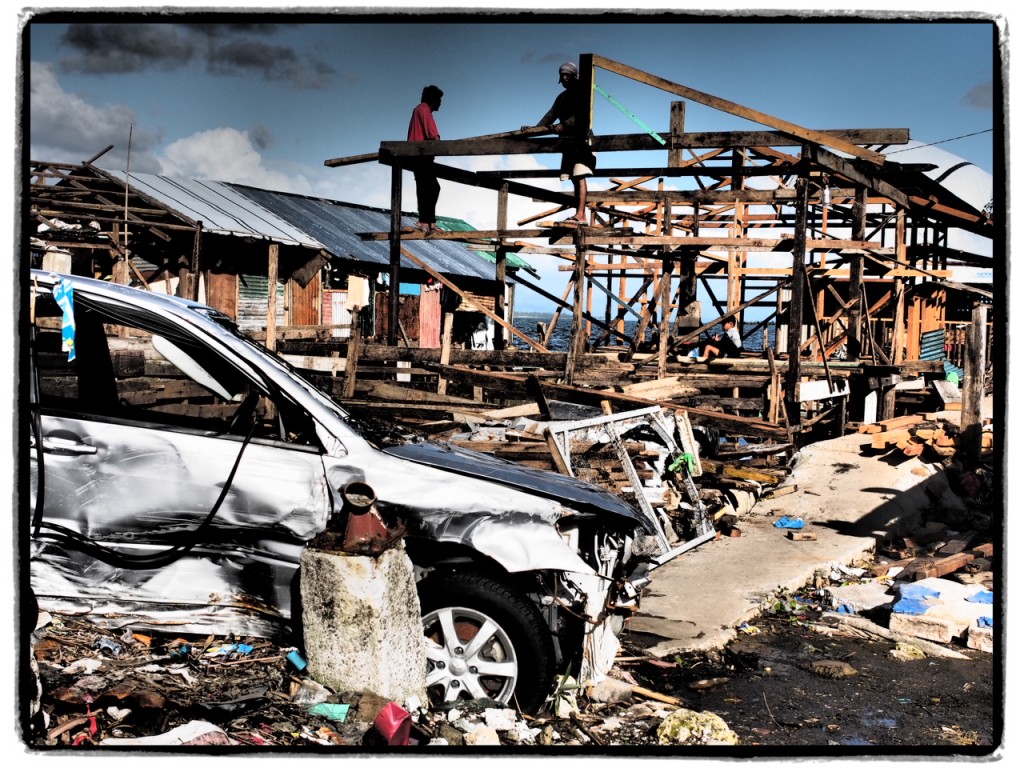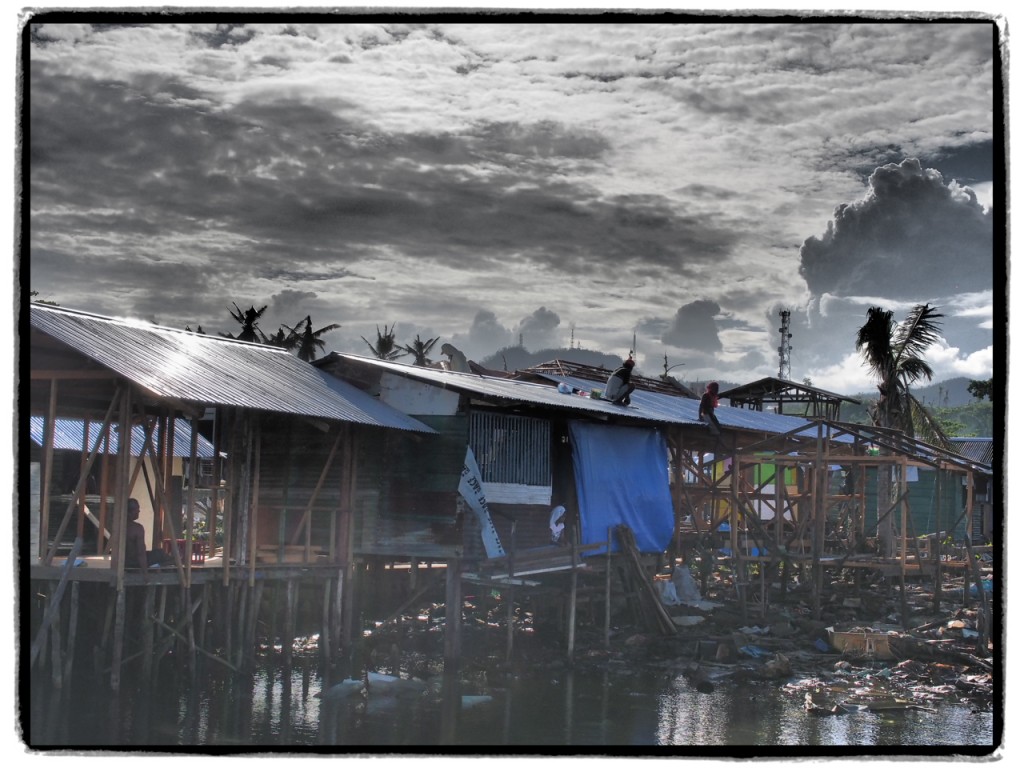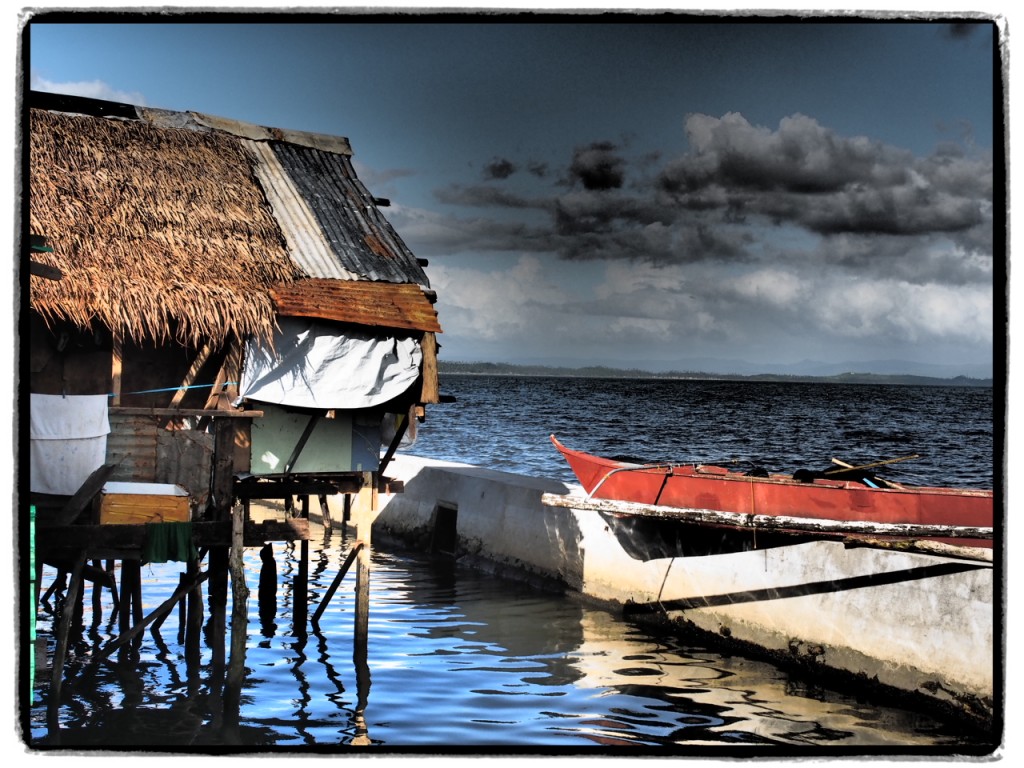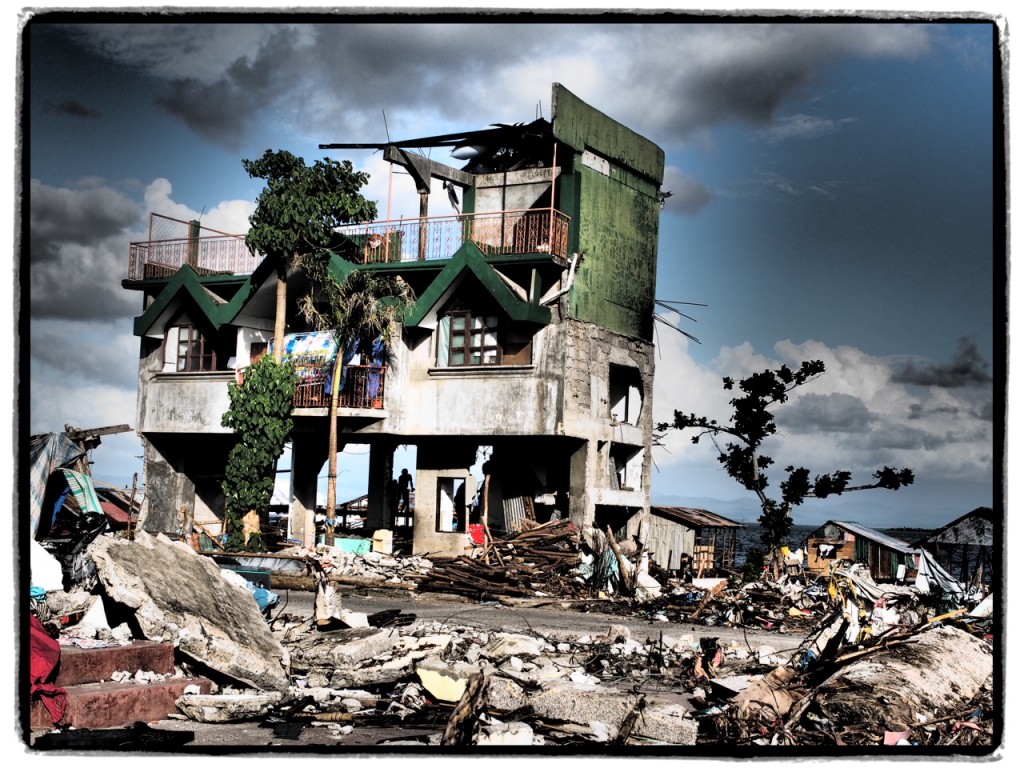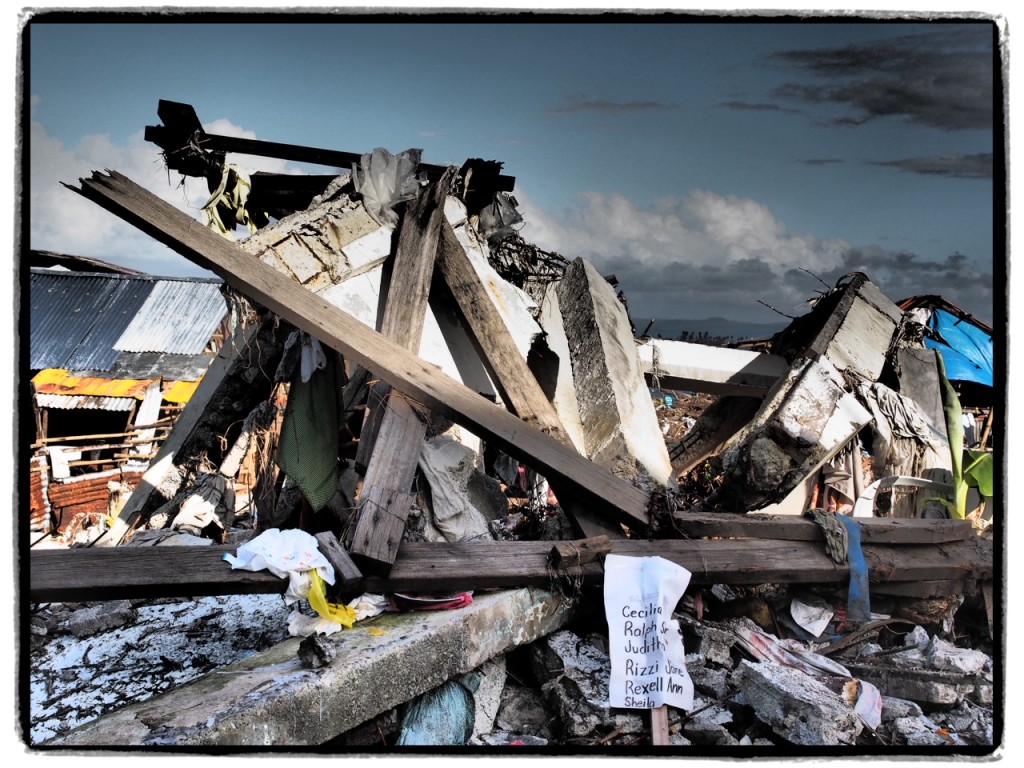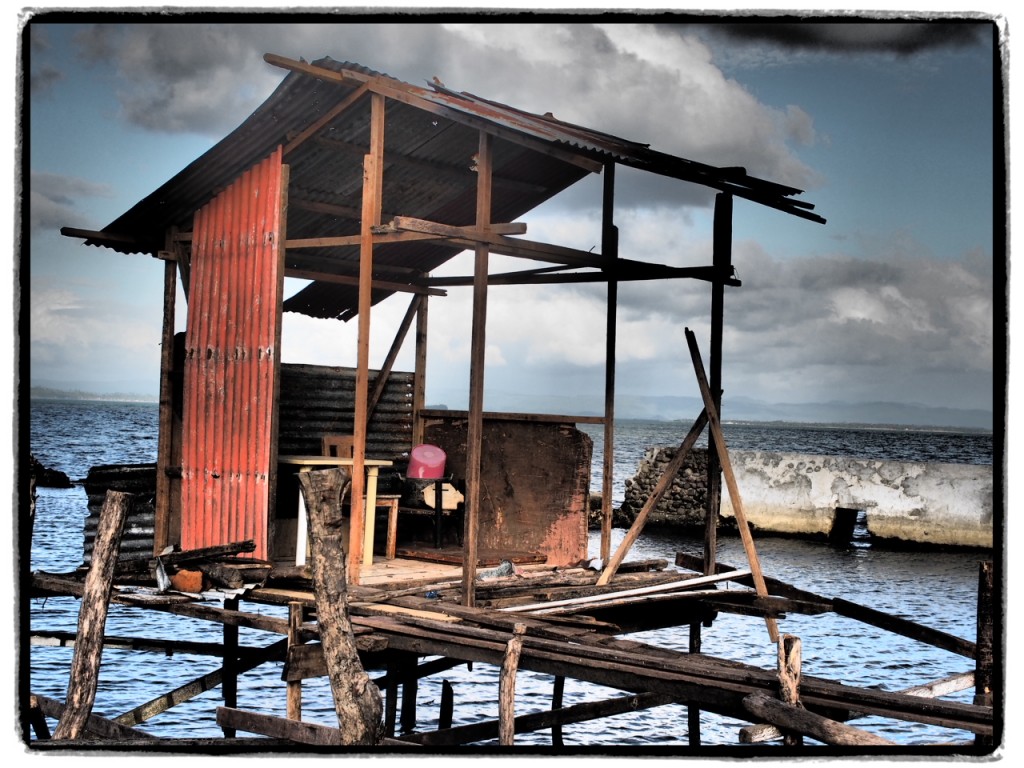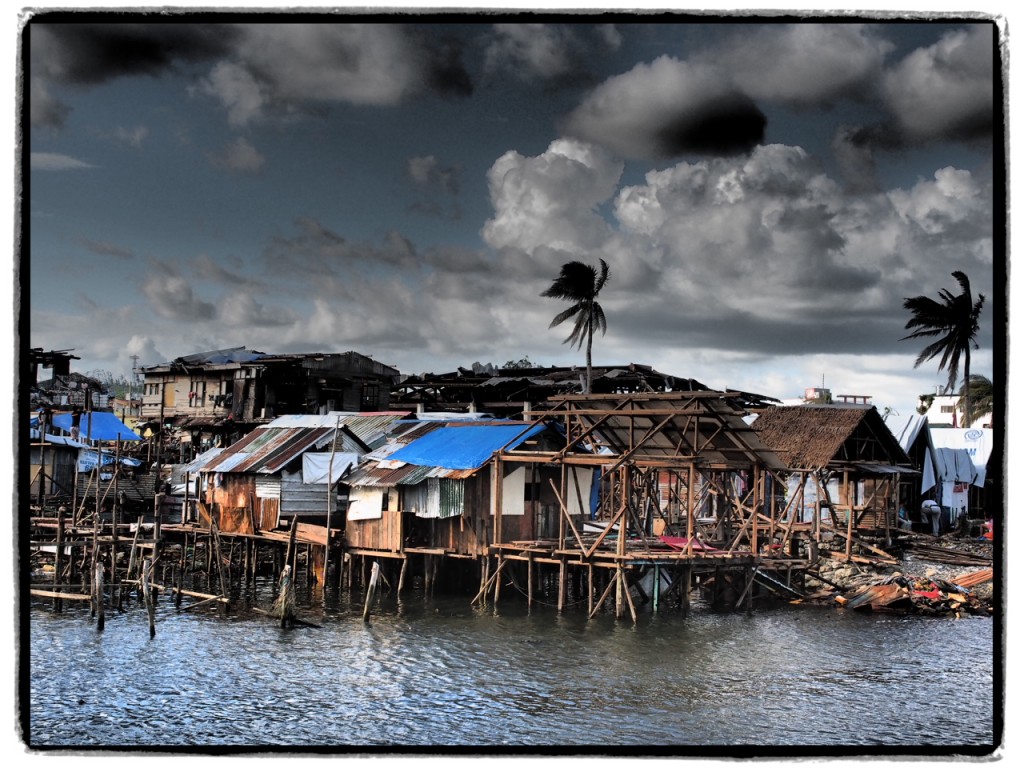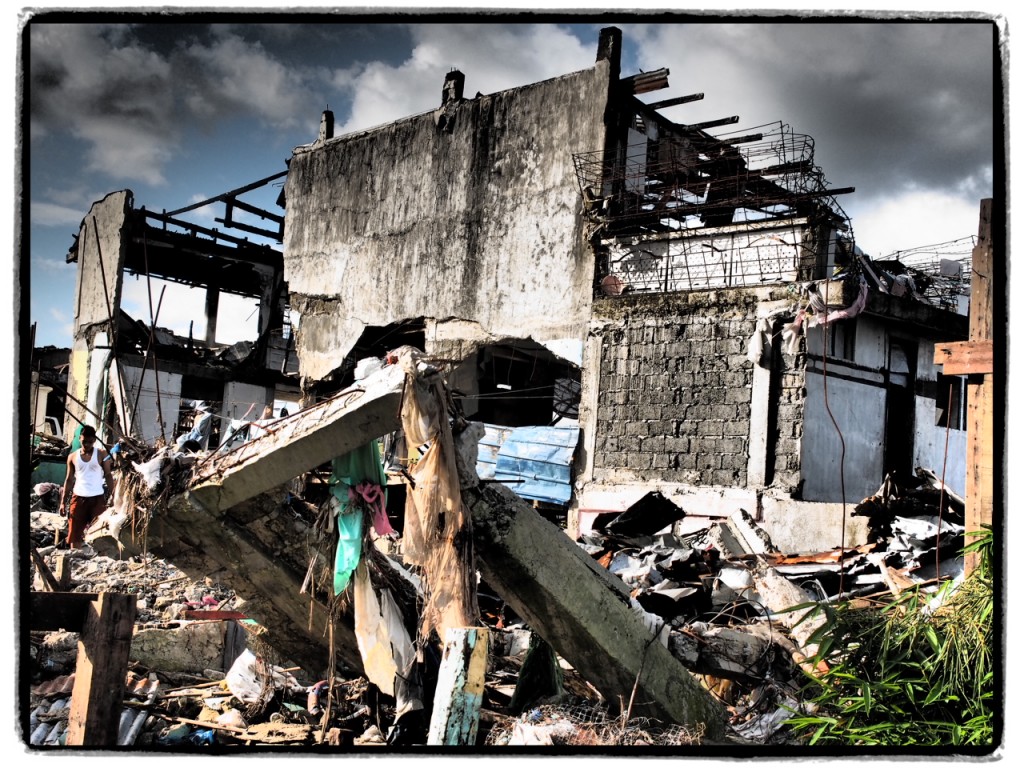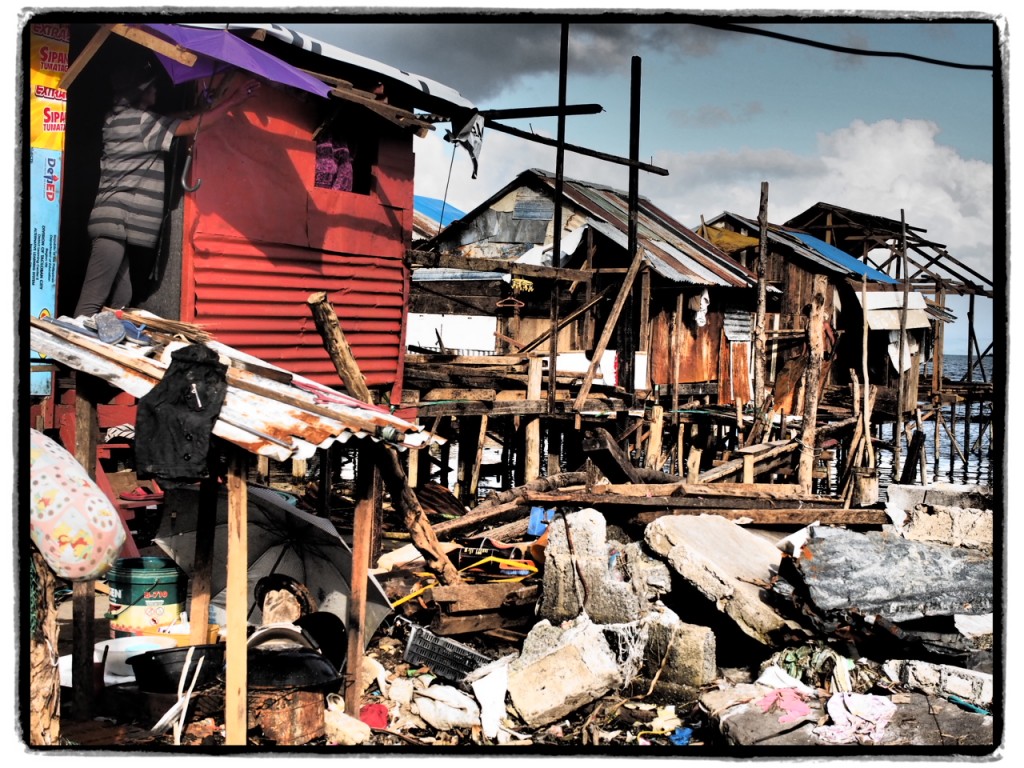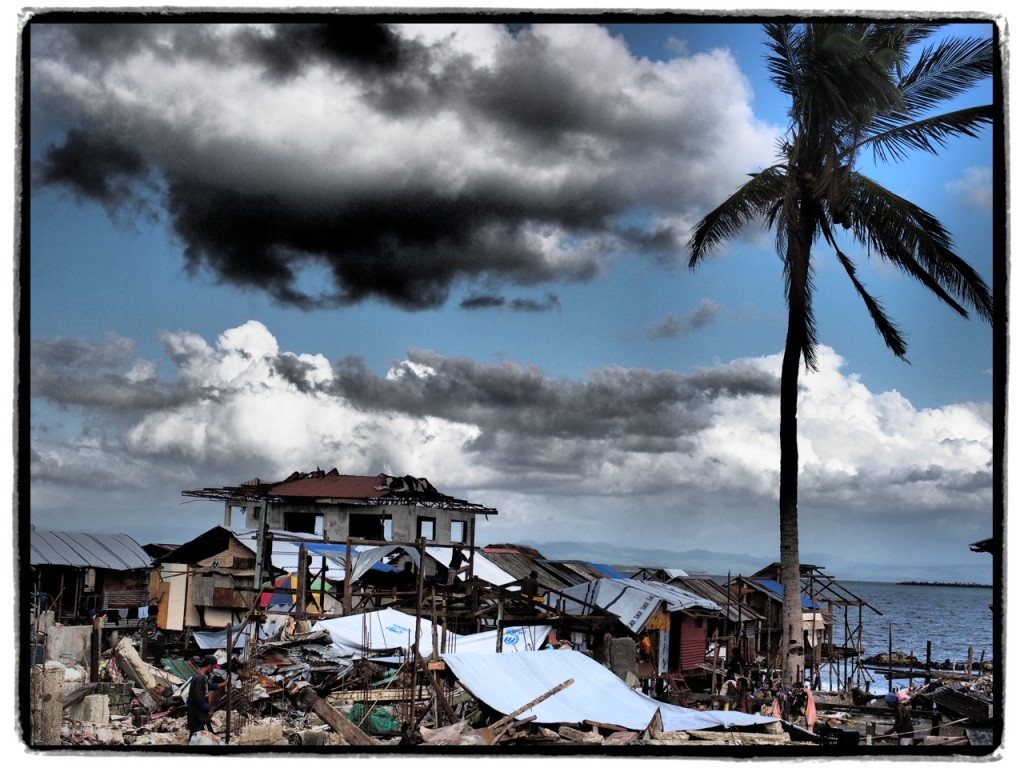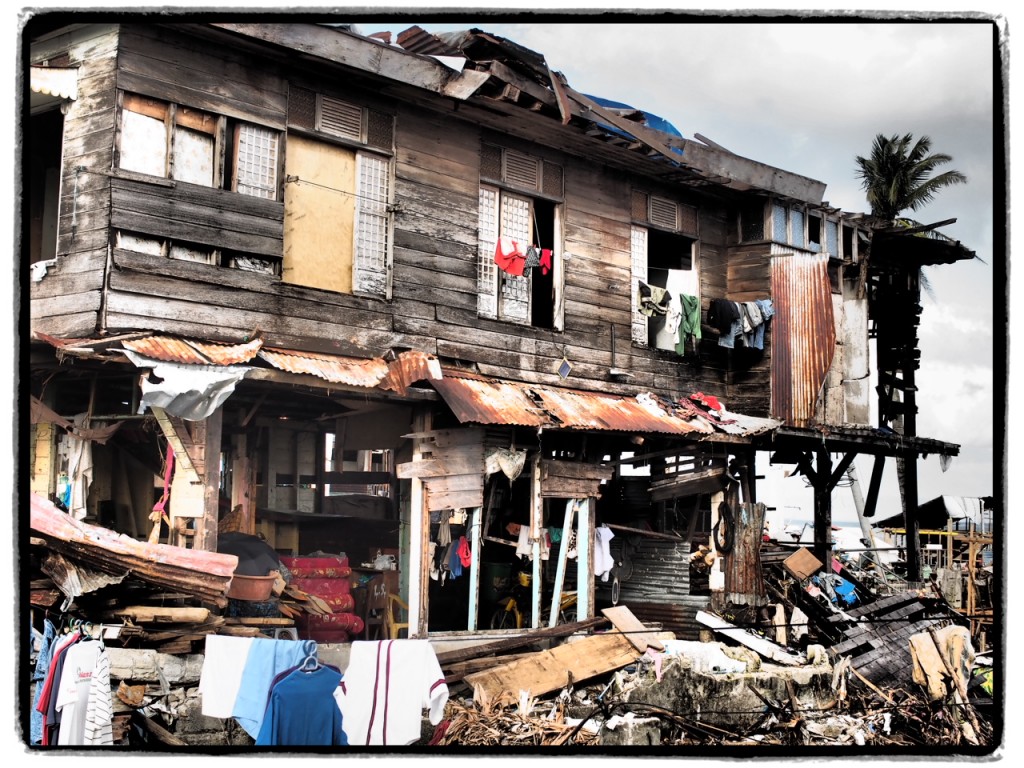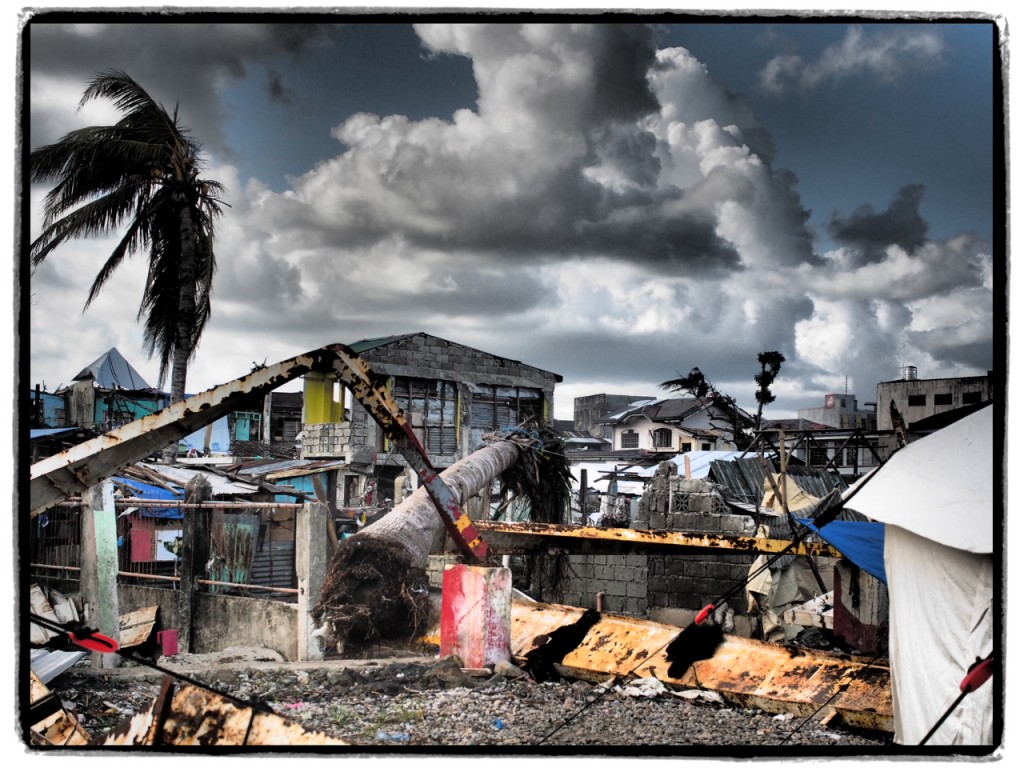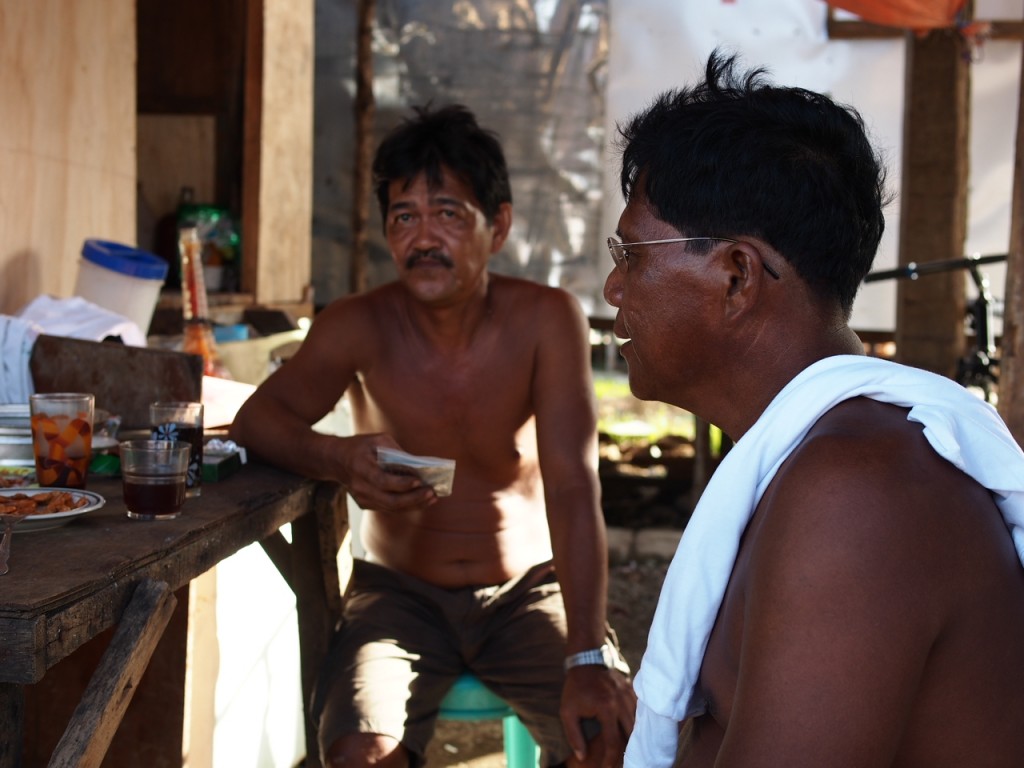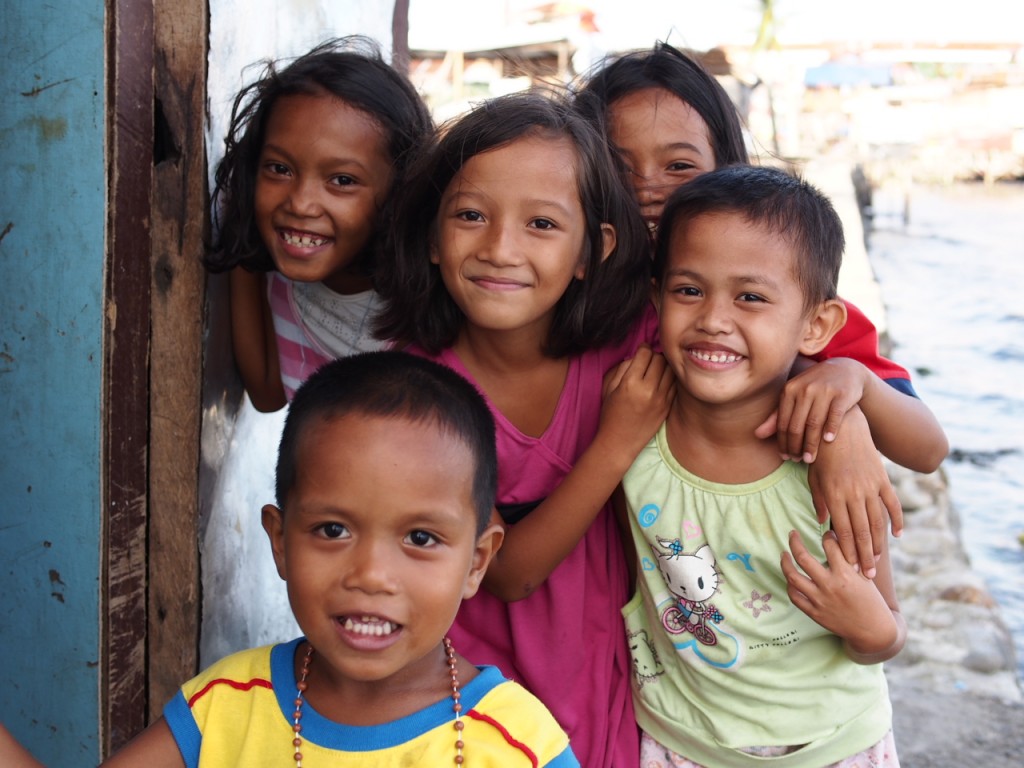These photos were all taken in and around the city of Tacloban on the island of Leyte in the Philippines nearly two months after super typhoon Yolanda struck on November 8, 2013. By this point, much of the debris had been removed from the shoreline communities and streets and people had begun rebuilding their homes and communities. The houses along the shoreline were a mixture of concrete and wooden structures. Few of them were able to withstand the force of the typhoon. Just a rare few, such as three houses, remained standing in any way. These three houses had their walls blown out while the cement columns stood. In this case, the owners of the houses had put up a galvanized tin fence to keep people from sorting through the rubble and taking what didn’t belong to them.
It continued to rain heavily in the days and even weeks after the typhoon had passed, and people were very grateful to receive donated tarps, such as this one from the Canadian government, to provide some moderate shelter from the elements.
After the typhoon, people rebuilt their homes with whatever material they could scavenge from the debris fields. This family house has been rebuilt since the typhoon on the exact spot where it stood before. Many families here used latrines like this even before the typhoon. These latrines were among the first things rebuilt.
Many large ships were blown ashore during the typhoon and ended up resting on top of what remained of residential neighborhoods. The people gathered by the ship have uncovered their old water supply and are busy getting water and doing their laundry. Uncovering wells and water pipes was a big priority after the typhoon. Luckily, Tacloban is well-supplied with water. This helped a lot with the recovery process and allowed people to clean their few muddy clothes and other possessions that they managed to find in the ruins.
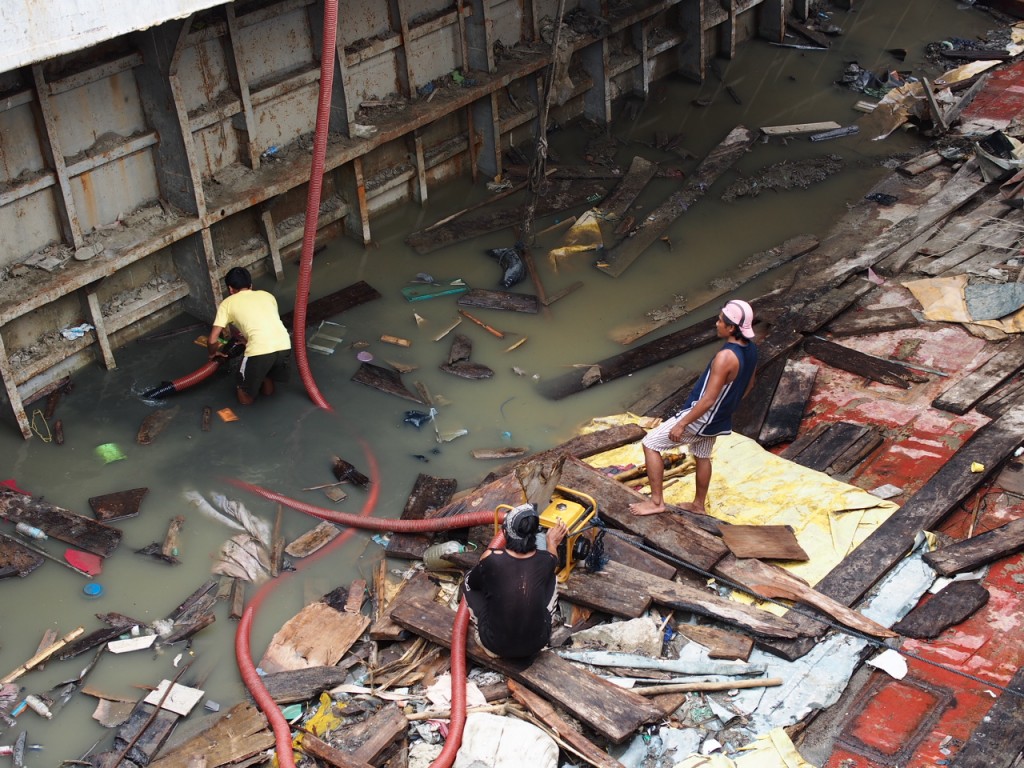
A salvage crew drains the water from inside a large ship that was blown ashore by super typhoon Yolanda
This ship contained a load of bags of cement. A salvage crew had recently finished lifting all of the (now hardened and ruined) bags of cement from the hold with a crane. The next step is to pump out the water. At some point, they will try to get the ship back into the water and floating, but I have no idea how they will be able to manage that.
People had to scavenge whatever they could from the piles of debris left by the typhoon in order to rebuild their homes, clothe themselves, feed themselves and otherwise survive. Sometimes it wasn’t clear who this debris belonged to, and people would stray inside private homes and help themselves to what they could find in a “finders keepers” state of mind. This led to homeowners putting fences around their homes and erecting “No Entry” signs. Many ex-homeowners stood guard over the piles of debris where their homes used to stand to prevent people from digging through the rubble and making off with valuables. I talked to one woman that was concerned about some guns that had been in her house and were now lost in the debris.
Many NGO’s distributed tents to families to use as emergency shelters after the typhoon. Other tents were taken from stores in Tacloban during the looting period. I’m not sure if this is a looted tent or a donated one. These tents were important not just as shelter from the rain but as protection from the large numbers of mosquitoes that practically took over the city. There was so much standing water in Tacloban that the mosquito population grew quickly.
The nature of the storm surge and the height of the waves and water that hit Tacloban is still something of a mystery to me. Official reports and the stories I heard from survivors didn’t seem to match up. People from this building told me that the water reached the roof rafters and they had to tie themselves to the wooden beams in order to avoid being swept away. That would put the water at a very high level – much higher than I heard in official reports. Also, I’ve only seen one small chunk of video footage showing a storm surge powerful enough to wash away buildings. The storm surge here was clearly powerful enough to wipe away nearly all the houses, but I still haven’t seen any video footage of it actually happening. It was so sudden that I assume people simply had no time to even take out their cell phones and film it.
This entire area was so thick with houses that you couldn’t see the water at all. All those wooden stilts are the foundations on which the houses once stood. After the typhoon, Tacloban seemed like an entirely new city to me. Before it, one rarely got a view of the water. There was no actual waterfront because it was completely covered with squatter settlements. Other areas were covered up by long cement fences. The typhoon wiped all of this away – not to mention knocking down all the trees – and residents suddenly had uninterrupted views of the water on all sides.
I was surprised to see that even two months after the typhoon, no houses had been rebuilt in this part of Magallanes in Tacloban City. In all the other areas, much of the houses had been rebuilt in some fashion. But here, nothing was rebuilt. This might be connected with a law that everyone was discussing, a law that homes could not be built within 40 meters of the shoreline. However, this law was clearly being ignored in other parts of Tacloban. I don’t know why it would be obeyed and/or enforced here but nowhere else.
I came to think of the typhoon as a triple attack. The powerful winds ripped the roofs off most buildings near the shore. The storm surge tore down the walls. And the rain soaked everything.
I have a strong suspicion that poor-quality concrete and low construction standards contributed to much of the damage caused by super typhoon Yolanda. Cement homes with steel rebar were destroyed just as easily as wooden structures. In one village, I experimented by stepping on some concrete blocks and they simply turned into sand and dust. There seemed to be no cement in them at all. If just the weight of my foot could cause these blocks to disintegrate, there is no way they could have stood up to the force of the typhoon winds and the storm surge.
After clearing away the many, many feet of wooden rubble, the next step was to remove the concrete of the old walls. This was done with hammers. Crews chipped away at the toppled pillars and then carted away the debris. This was extremely hard work. Once the ground was cleared, they could then begin the process of rebuilding. Almost everyone began by rebuilding with coco lumber. Over time and as they acquire enough money, they will replace the wood with concrete and take steps toward completing their homes as they used to be.
The UNHCR and other agencies provided many tents as temporary shelters for families whose houses had been destroyed. This particular field was a bit of a mystery to me because I never did see anyone in or around the tents. I assume families moved in, but if they did so, I never saw evidence of them.
Soon after the typhoon, I met a small family that rebuilt their home here. It is the tiny little house at the far right side of the line of houses out over the water. At the time, their house seemed quite forlorn as it was the only one in the entire area. Soon afterward, it was nearly surrounded by other houses. It was interesting for me to speak with people from various NGOs that arrived at this time. They looked at these houses and imagined that they represented the damage from the typhoon. What they didn’t know was that after the typhoon, there was nothing here at all. This was an empty field with a clear view of the ocean water. All the houses visible had been rebuilt AFTER the typhoon.
In the days and weeks after the typhoon, this street was completely impassable. The debris of the destroyed houses filled it to a depth of between ten and fifteen feet – sometimes even more. Heavy equipment and large numbers of dump trucks were needed to clear away all the debris.
I was astonished to see the damage that had been done to cars and other vehicles. This car is relatively undamaged compared to some that I saw. It bears witness to the force of the storm surge and the flood. Cars and trucks and jeepneys and tricycles were slammed around in the floodwaters and ripped apart.
I visited the coastal communities (mainly squatter settlements) nearly every day in the months after the typhoon, and I never ceased to be astonished at the scale of the destruction and then the speed with with the local people rebuilt their homes. These houses appeared practically overnight. It was in stark contrast with what I kept hearing about the government and NGOs building temporary housing. There was a lot of talk of corruption and profiteering related to the construction of temporary shelters – what were referred to as bunkhouses. When, much later, I had access to newspapers and read the articles it all seemed like so much nonsense. The idea was to build these temporary shelters for families because it would take up to two years to rebuild permanent homes for them. Meanwhile, all the local families had just set to work and rebuilt their own homes – like these ones. So who were all these “bunkhouses” for? When I finally left Tacloban on my bicycle nearly three months after the typhoon struck, I saw construction crews still working away on long rows of these bunkhouses outside Tacloban. No families had moved into any of them. They were just empty wooden shells. All of this effort seemed like far too much too late.
This building was a favorite photo op for me and many photojournalists who passed through Tacloban. From a distance, with the flattened buildings and debris around it, it reminded me of photographs I’ve seen of the destruction caused by large scale bombing during World War II.
I’m not entirely sure, but my guess is that this sign contains a list of the people who died at this spot. I was surprised, actually, to see very few memorials to the people who died during super typhoon Yolanda. Perhaps it is a cultural thing, but considering the thousands of people who died here, I thought there would be small, informal memorials at the very least. Bodies were, for the most part, collected by government agencies (like the Bureau of Fire Protection) and placed in mass graves. There was no real possibility for funerals and private burials even if local people could afford them. Still, it would have been a simple matter to erect a small cross or other marker if only temporarily. But I saw almost nothing like that anywhere. In one unusual move, the local authorities in the town of Tanauan had allowed people to bury family members in a traffic island leading into the town – right where the “Welcome to Tanauan” sign was located. There was no room left in any of the cemeteries. One can applaud the city government’s initiative, but it will certainly be an odd welcome to the city in years to come.

